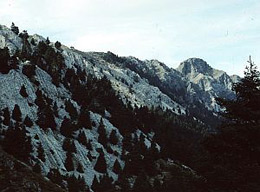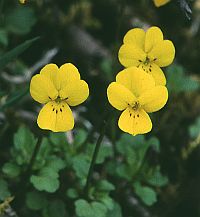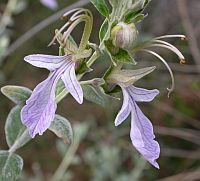 |
Grazalema's renowned
Spanish fir forests
 El Pinsapar
© Teresa Farino
El Pinsapar
© Teresa Farino
No visit to Grazalema would be complete without a visit to the pinsapar, for which you will need a permit
(available from the El Bosque information centre (see below); apply early as numbers are limited),
although access is forbidden in July and August, when the risk of fire is at its peak. The trail starts on
the CA-531, which links Grazalema with Zahara, with the car-park located a couple of kilometres north of the
turn-off (A-372) to El Bosque. The early part of the path is bare of trees and harbours floriferous clumps
of blue-aphyllanthes (only when the sun is shining) as well as shrubby gromwell, cushions of spiny hare's-ear
and Chaenorhinum villosum, drifts of the white-flowered Cerastium boissieri, pink-flowered mats of putoria
and the occasional diminutive spike of the Afro-Iberian endemic Anarrhinum laxiflorum.
The planted pines - mostly aleppo and maritime - which clothe the middle section of the ascent are of
lesser botanical interest, but crested tits are common here and you might also catch sight of a sparrowhawk
zooming through the trees. Eventually you reach the Puerto de las Cumbres, with its splendid view along the
northern flank of the Sierra del Pinar, densely clothed with Spanish firs, although this is often only
appreciated in small fragments, through gaps in the drifting cloud which so often shrouds Grazalema's highest
peaks.
 Viola demetria
© Teresa Farino
Viola demetria
© Teresa Farino
The onward path contours through limestone rock gardens, now at around 1,300m, populated by a completely
different assemblage of plants. May is one of the best times to do this walk, when drifts of the diminutive
rush-leaved jonquil (here subspecies praelongus) and crocus-like Romulea bulbocodium are still in flower,
accompanied by the candytuft-like Ionopsidium prolongoi, the tiny yellow Viola demetria and Senecio minutus,
all of which are Afro-Iberian endemics, spring rock-cress, and the saxifrages Saxifraga haenseleri, found
only in the Sierras Béticas, and S. globulifera, which also occurs in North Africa. Cushions of hedgehog
broom and the white-flowered crucifer Hormathophylla spinosa line the path, while the cliffs up to the left
harbour the lovely Draba hispanica, whose tight clusters of yellow flowers grow only on limestone mountains
in southern and eastern Spain. In spring you might also turn up a few Barton's and dense-flowered orchids
here, plus a few nodding purplish-green bells of the snakeshead Fritillaria hispanica, but later in the year
this is one of the prime sites in which to track Grazalema's most emblematic endemic: the delicate, brick-red
poppy Papaver rupifragum.
Spanish fir Abies pinsapo
A relict species of the last Ice Ages, pushed south by the advancing ice sheets, then stranded when they
retreated, today only found on north-facing slopes with high humidity. Only about 1,200ha of these ancient
forests remain in Spain, confined to the Sierras de Grazalema, las Nieves and Bermeja, in the provinces of
Cádiz and Málaga, although further expanses occur in the western Rif (North Africa). Spanish firs - in Spanish
known as pinsapos - attain a height of about 30m and have a distinctive pyramidal shape; the species was first
described from the Sierra Bermeja, by the Swiss botanist Boiss in 1838.
In the Grazalema park, the rigorous control of domestic livestock on the Sierra del Pinar means that the
pinsapar is gradually expanding; when purchased by the Andalucían government in 1972 the forest covered about
300ha, which has increased to more than 420ha today. Some of the trees here have trunks almost a metre in
diameter and are thought to be more than 500 years old.
The taller vegetation before you reach the fir forest is composed mainly of Montpellier maple, Berberis
hispanica, whitebeam and hawthorn, the latter host to yellowish-green clumps of the red-berried mistletoe
Viscum cruciatum, yet another Afro-Iberian endemic. Scrub warblers abound here, notably Dartford, Sardinian
and subalpine, although you won't see much evidence of their presence if the cloud is down, while the
limestone crags on both sides of the path often harbour small groups of Spanish ibex.
 Tree Germander
Tree Germander
Teucrium fruitcans
© Teresa Farino
Once within the gloomy confines of the pinsapar, the flora becomes markedly less interesting, dominated by
spurge-laurel, shrubby hare's-ear, Etruscan honeysuckle, stinking hellebore and stinking iris in the upper
reaches, although as you descend watch out for plantain-leaved leopard's-bane and red and sword-leaved
helleborines along the sides of the path, while sheets of peonies Paeonia coriacea carpet the floor from
late May onwards. This humid enclave is also favoured by ferns such as Dickie's and brittle bladder-ferns.
Few birds seem to appreciate the dense coniferous foliage, with only wrens, robins, Bonelli's warblers,
Iberian chiffchaffs and coal tits present in any numbers, although you might also encounter a short-toed
treecreeper or two.
If you decide to continue through the fir forest and down to Benamahoma, plants to look out for on the
way include western peonies, grass-leaved buttercups, tree germander, shrubby scorpion-vetch,
the evil-smelling bean trefoil and the red-flowered Cytinus ruber, parasitic on the belt of grey-leaved
cistus which lines the path. The grassy slopes at the foot of the sheer cliffs up to the left are often
studded with foraging Spanish ibex, while griffon vultures are a constant presence overhead. West of
Benamahoma, a well-marked trail runs along the Río de El Bosque - one of the few that doesn't disappear
underground in the summer - through a green corridor of riverine forest where you should turn up golden
oriole and dipper and might even catch a glimpse of one of the otters that inhabit this stretch of water.
The Grazalema Tourist Information Centre, nowadays run by English naturalists Clive Muir and Sue Eatock, is located in the lower car park/market place of the town of Grazalema. Maps, walking guides and books about the wildlife of the park are available here, and you can also apply for permits for the walking routes of El Torreón, El Pinsapar (the Spanish Fir forest) and the Garganta Verde (400m-deep, and home to a sizeable griffon vulture colony). Contact details: Plaza de los Asomaderos 3; Tel/Fax: (+34) 956 13 20 52. |